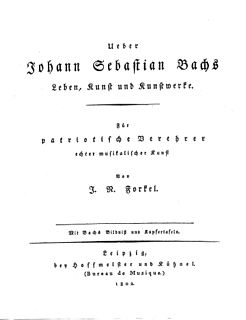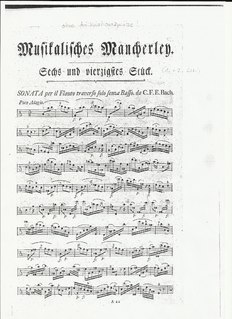Carl Philipp Emanuel Bach, also formerly spelled Karl Philipp Emmanuel Bach, and commonly abbreviated C. P. E. Bach, was a German Classical period musician and composer, the fifth child and second surviving son of Johann Sebastian Bach and Maria Barbara Bach. His second name was given in honor of his godfather Georg Philipp Telemann, a friend of Johann Sebastian Bach.

Wilhelm Friedemann Bach, the second child and eldest son of Johann Sebastian Bach and Maria Barbara Bach, was a German composer and performer. Despite his acknowledged genius as an organist, improviser and composer, his income and employment were unstable and he died in poverty.

Christopher Jarvis Haley Hogwood was an English conductor, harpsichordist, writer, and musicologist. Founder of the early music ensemble the Academy of Ancient Music, he was an authority on historically informed performance and a leading figure in the early music revival of the late 20th century.

The title Notebook for Anna Magdalena Bach refers to either of two manuscript notebooks that the German Baroque composer Johann Sebastian Bach presented to his second wife, Anna Magdalena. Keyboard music makes up most of both notebooks, and a few pieces for voice are included.

Gustav Leonhardt was a Dutch keyboard player, conductor, musicologist, teacher and editor. He was a leading figure in the movement to perform music on period instruments. Leonhardt professionally played many instruments, including the harpsichord, pipe organ, claviorganum, clavichord, fortepiano and piano. He also conducted orchestras and choruses.
Alfred Wotquenne was a Belgian musical bibliographer, best known for his catalogues of the works of Carl Philipp Emanuel Bach and Christoph Willibald Gluck.
Carl Philipp Emanuel Bach: The Complete Works is a new critical edition of the music and keyboard treatise by C.P.E. Bach. The project was begun in 1998–99 in the wake of the aborted Carl Philipp Emanuel Bach Edition, and many of the same eminent music scholars associated with the earlier incomplete edition have become involved with the new one. From 1999–2014, the new edition was chaired by Christopher Hogwood. After his death in 2014, Robert D. Levin was appointed chair. The general editors are Darrell Berg, Peter Wollny, and Ulrich Leisinger. The edition is published by the Packard Humanities Institute. The current Editorial Guidelines are available in PDF format on the edition’s website: http://www.cpebach.org.

Johann Sebastian Bach was a German composer and musician of the Baroque period. He is known for instrumental compositions such as the Brandenburg Concertos and the Goldberg Variations, and for vocal music such as the St Matthew Passion and the Mass in B minor. Since the 19th-century Bach Revival, he has been generally regarded as one of the greatest composers of all time.
As Kapellmeister at Hamburg from 1768 to 1788, Carl Philipp Emanuel Bach composed 21 settings of the Passion narrative and 1 Passion oratorio.

The Sonata in E major for flute and basso continuo is a sonata for transverse flute and figured bass composed by Bach in the 1740s. It was written as the result of a visit in 1741 to the court of Frederick the Great in Potsdam, where Bach's son Carl Philipp Emanuel had been appointed principal harpsichordist to the king the previous year. It was dedicated to Michael Gabriel Fredersdorf, the king's valet and private secretary, who, like the king, was an amateur flautist.
Richard Douglas P. Jones is a British musicologist and editor, known especially for his work as a Bach scholar. After graduating from the University of Oxford, he has taught at Cardiff University and Sheffield University.
The Carl Philipp Emanuel Bach Chamber Orchestra was a German chamber orchestra, founded in 1969 in Berlin, dedicated to the music of Carl Philipp Emanuel Bach and his contemporaries.

Geistliche Oden und Lieder, also known as Gellert Oden, is a collection of songs by Carl Philipp Emanuel Bach with texts by Christian Fürchtegott Gellert. Originally published in 1758, Bach's work enjoyed continuous popularity for several decades and influenced numerous composers, most importantly Ludwig van Beethoven, who composed his own settings of six of Gellert's poems.

Johann Sebastian Bach: His Life, Art, and Work is an early 19th-century biography of Johann Sebastian Bach, written in German by Johann Nikolaus Forkel, and later translated by, among others, Charles Sanford Terry.
The Triple Concerto, BWV 1044, is a concerto in A minor for traverso, violin, harpsichord, and string orchestra by Johann Sebastian Bach. He based the composition on his Prelude and Fugue BWV 894 for harpsichord and on the middle movement of his Organ Sonata BWV 527, or on earlier lost models for these compositions.
The concerto transcriptions of Johann Sebastian Bach date from his second period at the court in Weimar (1708–1717). Bach transcribed for organ and harpsichord a number of Italian and Italianate concertos, mainly by Antonio Vivaldi, but with others by Alessandro Marcello, Benedetto Marcello, Georg Philipp Telemann and the musically talented Prince Johann Ernst of Saxe-Weimar. It is thought that most of the transcriptions were probably made in 1713–1714. Their publication by C.F. Peters in the 1850s and by Breitkopf & Härtel in the 1890s played a decisive role in the Vivaldi revival of the twentieth century.

The Sonata for Solo Flute in A minor, Wq.132, H 562, is a sonata for flauto traverso without basso continuo or accompanying instruments composed by Carl Philipp Emanuel Bach. The sonata is considered, along with Telemann's Fantasias for Solo Flute and J. S. Bach's A minor partita, one of the most significant works for unaccompanied flute before the 20th century. It is the sole flute work by Bach that was printed and published during his lifetime. No manuscript of it has been discovered.

In the period following Johann Sebastian Bach's death in 1750, apart from the publication of The Art of Fugue in the early 1750s, the only further publications prior to the 1790s were the settings of Bach's four-part chorales. In 1758 Friedrich Wilhelm Marpurg was the first to start preparing a published edition of Bach's four-part chorales, but in 1763 was prevented by royal duties. C. P. E. Bach, who owned the original manuscripts, then set about the same task, producing two volumes in 1765 and 1769. Dissatisfied with his publisher Friedrich Wilhelm Birnstiel, he surrendered the manuscript rights in 1771 to Johann Kirnberger and his patron Princess Anna Amalia of Prussia. From 1777 onwards, Kirnberger unsuccessfully made requests to Birnstiel and a new publisher, Johann Gottlob Immanuel Breitkopf, to publish the chorales. Following Kirnberger's death in 1783, C.P.E. Bach approached Breitkopf, who published them in four volumes between 1784 and 1787.